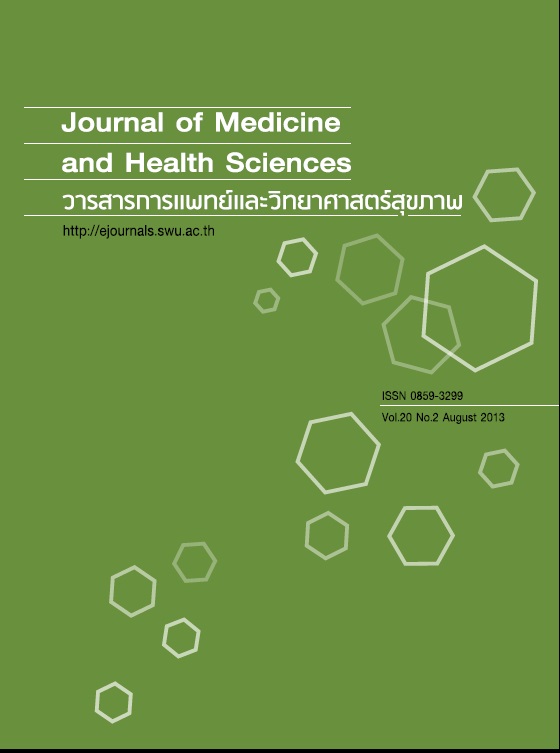Correlation of lateral spinal curvature and Conicity index in Thai women and Conicity index in Thai women
Keywords:
ค่าดัชนีไขมันหน้าท้อง, น้ำหนักตัวเกินมาตรฐาน, ความโค้งของกระดูกสันหลัง, Conicity index, Overweight, Spinal curvatureAbstract
Being obesity is a common health problem in women. Obese women have fat deposited at upper body and waist. Due to a large amount of subcutaneous tissue deposit in the upper body and around the waist, the center of gravity had a tendency to fall in front of the lumbar spine, leading to an adjusted body position. This could change the spinal curvature. The purposes of this study were to determine the correlation between spinal curvature, thoracic and lumbar curvature, and Conicity index in overweight and normal weight women. This study also compared the spinal curvature between over weight and normal weight women. Seventy five women aged 30-40 years old participated in this study, 31 women in the overweight group with a body mass index more than 24.99 kg/m2 and 44 in normal weight group with body mass index 18.50 to 24.99 kg/m2 . The spinal curvature was measured by using an Inclinometer on the X-ray photograph. The Conicity index was calculated from the value of waist circumference of each participant. The results showed no correlation between Conicity index and thoracic spinal curvature (r=0.003) and lumbar spinal curvature (r=-0.077). There was no significant difference in either thoracic or lumbar spinal curvature between overweight group (mean of thoracic and lumbar curvature = 21.24º, 26.34º, mean of Conicity index = 1.24) and normal weight group (mean of thoracic and lumbar curvature = 21.85º, 27.94º, mean of Conicity index = 1.20). There was no correlation between Conicity index and spinal curvature. Spinal curvature between overweight and normal weight groups showed no significant difference. Therefore, it is interesting to further study whether fat deposit affects the spinal curvature in children and adult who are obese.
ความสัมพันธ์ระหว่างความโค้งแนวด้านข้างของกระดูกสันหลังกับค่าดัชนีไขมันหน้าท้องในหญิงไทย
ความอ้วนเป็นปัญหาสุขภาพที่พบมากในเพศหญิง ความอ้วนมีการสะสมไขมันที่ส่วนบนของร่างกายและบริเวณเอว เนื่องจากการสะสมไขมันจำนวนมากที่ส่วนบนของร่างกายและเอว จะทำให้จุดศูนย์ถ่วงของร่างกายมีแนวโน้มตกผ่าน ด้านหน้าของกระดูกสันหลังส่วนเอว ซึ่งทำให้ร่างกายมีการปรับท่าทาง ซึ่งความโค้งของกระดูกสันหลังอาจจะเปลี่ยนแปลง ไปได้ การศึกษานี้เพื่อศึกษาความสัมพันธ์ระหว่างความโค้งของกระดูกสันหลังระดับอกและเอวกับค่าดัชนีไขมันหน้าท้องใน กลุ่มที่มีน้ำหนักตัวเกินมาตรฐาน (overweight) และกลุ่มน้ำหนักตัวปกติ (normal) และเปรียบเทียบค่าความโค้งของ กระดูกสันหลังระหว่างกลุ่มน้ำหนักตัวเกินมาตรฐานและกลุ่มน้ำหนักตัวปกติ ผู้เข้าร่วมการวิจัย คือ เพศหญิง 75 คน ช่วงอายุ 30-40 ปี คือ 1) กลุ่มน้ำหนักตัวเกินมาตรฐานที่มีดัชนีมวลกายมากกว่า 24.99 กก./ม.2 จำนวน 31 คน 2) กลุ่มน้ำหนักตัวปกติที่มีดัชนีมวลกาย 18.5-24.99 กก./ม.2 จำนวน 44 คน วัดค่าความโค้งของกระดูกสันหลังแนวด้านข้าง ระดับอกและเอวโดยใช้เครื่องมือ Inclinometer จากภาพถ่ายรังสีเอ็กซ์ และวัดเส้นรอบวงเอวเพื่อคำนวณค่าดัชนีไขมัน หน้าท้อง ผลการวิจัย ไม่พบความสัมพันธ์ระหว่างค่าดัชนีไขมันหน้าท้องกับค่าความโค้งของกระดูกสันหลังระดับอก (r = 0.003) และเอว (r = -0.077) และไม่พบความแตกต่างของค่าความโค้งของกระดูกสันหลังส่วนอกและเอวระหว่างกลุ่ม น้ำหนักตัวเกินมาตรฐาน (ค่ามาตรฐานเฉลี่ยของมุมความโค้งอกและเอว = 21.24, 26.34 องศา ค่าเฉลี่ยดัชนีไขมันหน้าท้อง = 1.24) กับกลุ่มน้ำหนักตัวปกติ (ค่าเฉลี่ยของมุมความโค้งอกและเอว = 21.85, 27.94 องศา ค่าเฉลี่ยดัชนีไขมันหน้าท้อง = 1.20) สรุปคือค่าดัชนีไขมันหน้าท้องกับค่าความโค้งของกระดูกสันหลังไม่มีความสัมพันธ์กัน และค่าความโค้งของกระดูก สันหลังระหว่างกลุ่มน้ำหนักตัวเกินมาตรฐานและกลุ่มน้ำหนักตัวปกติไม่แตกต่างกัน ในอนาคตควรศึกษาในกลุ่มโรคอ้วน (obesity) ทั้งในเด็กและผู้ใหญ่เพิ่มเติม



